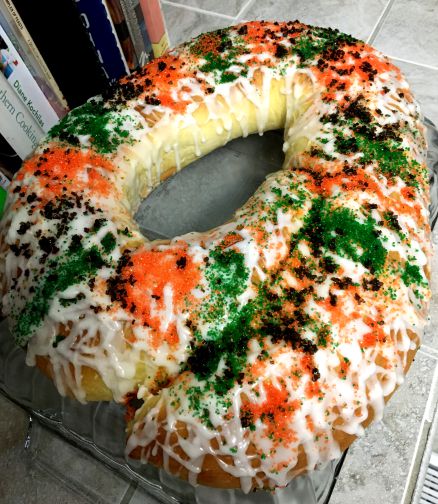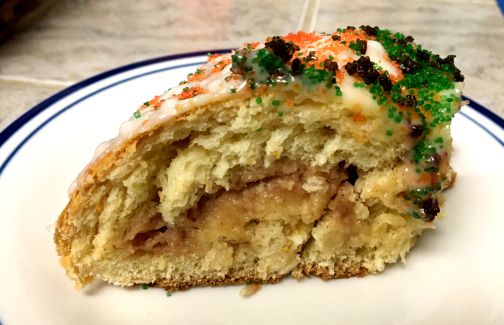
KING CAKE
WITH CREAM CHEESE FILLING

Patsy R. Brumfield, The Southfacin’ Cook
Note: I made several King Cakes a few years ago from a recipe by a noted New Orleans chef. It was good but not as good as my mouth requested. I’m trying this from a NOLA home-cook. It doesn’t require the “braiding” dough technique, so it may be a bit simpler. Let’s give it a go!
COOK TIME: 30 mins
DOUGH TIME: 2 shifts, total 2 hours 15 mins
EQUIPMENT: Measuring gear, stand mixer, various small bowls for ingredients, large mixing bowl, rolling pin or equivalent*, plastic wrap, microplane, juicer, cooking spray, large baking sheet, small (3-inch wide) oven-proof ramekin, rubber spatula, whisk
INGREDIENTS
For the dough:
½ cup warm water (about 110 degrees)
2 packages active dry yeast
2 teaspoons sugar
4-5 cups flour
½ cup sugar
2 teaspoons salt
1 teaspoon freshly ground nutmeg
Zest of one lemon
½ cup warm milk (same as water)
½ cup melted unsalted butter, cooled
5 egg yolks
Option: King Cake Baby or dried kidney bean
For cream cheese filling:
1 8-oz. package cream cheese, room temp
1 cup confectioners’ sugar
2 Tablespoons flour
1 teaspoon vanilla
2 teaspoons lemon juice
2 teaspoons ground cinnamon

For icing:
2 cups confectioners’ sugar
4 Tablespoons lemon juice
1 teaspoon vanilla
Purple, green, yellow sanding sugar
LET’S GET STARTED
Take a deep breath and prep ingredients for the dough. Don’t just jump into this. Be prepared, as the Scouts say. *If you don’t have a rolling pin, use a beer bottle or glass, or your hands to shape the dough. It’s your cake!

- In a cereal bowl, combine warm water with yeast and 2 teaspoons sugar. Mix and let sit about 10 minutes. You’ll see the mixture get fluffy and rise. If not, your yeast is dead. Get more.
- In bowl of stand mixer, combine 4 cups flour, sugar, salt, nutmeg, lemon zest, milk, melted butter, egg yolks and yeast mixture.
- Using the dough hook, knead until the dough pulls away from the sides of the mixture (about 5 minutes). If the dough is very wet, add up to one more cup flour (I added ½ cup).
- Turn dough out into large bowl coated with cooking spray. Turn dough in the spray to cover, then cover bowl with plastic wrap. Let dough rise until it’s doubled, about 90 minutes.
- In mixer or with hand whisk, mix cream cheese, confectioners’ sugar, flour, vanilla and lemon juice. Set aside.
- On the countertop, using your hands and/or a rolling pin (I used both) roll dough about 30 inches long and wide enough to spread cream cheese mixture evenly, (let’s say about 6-7 inches wide, leaving about half inch of bare dough on rear side). Spread the cream. Roll dough into a cylinder like you’d shape a jelly roll – start at front edge creating a lip away from your body and gently roll that lip toward the back-side of the dough. When you’re about ¾ to the back, grasp the back lip and pull it over the rolled front.
- Line baking sheet with parchment paper. Place your oven-proof ramekin in the middle and gently wrap the dough – seam side down – around it in whatever circle you can arrange. Wrestling the dough is a little tricky – just do your best. Tuck the ends under or together to form a ring. Cover with a towel and let rise another 45 minutes.
- Preheat oven to 350. Bake the cake about 30 minutes or until golden brown. Carefully remove the hot ramekin and let the cake cool about 30 minutes. Lift the edge and push the “baby” into the underside.
- Make the icing by mixing ingredients together, mixer or by hand. Cover the cooled cake with the icing, either completely or with a drizzling motion from a spoon or whisk held 3-6 inches above (my preference).
- Sprinkle sugars in whatever artistic fashion strikes you. I like a scattered design, rather than solid stripes.

SPRINKLES SUGGESTION: If you can’t find sand sugar, colored sprinkles will do. Or – my preferred method – create your own sand sugars using 1/3 cup “raw” sugar per color, one color at a time, mixing with food coloring and drying in a 170-degree oven about 15 minutes. Don’t dawdle getting it into the oven or the sugar will melt! Spread out “wet” sugar on a parchment paper-lined baking sheet. Allow to cool before sprinkling.












